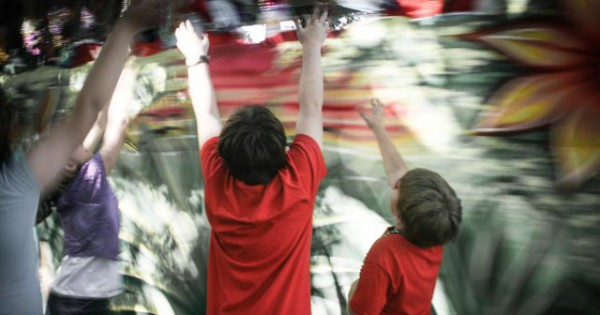
When I went to my first major Mardi Gras parade a few months after moving here, my initial thought was, whoa, what’s up with all these people getting so excited about cheap plastic beads? Their lives must be sad and lonely. My second thought, several moments later, was, I WANT SOME BEADS RIGHT NOW THROW THEM TO ME RIGHT NOW. Overall, it served as a good illustration of how contagious and irrational mobs and manias can be.
Catching “throws” is a large part of the New Orleans parade experience. It started in 1870. Ever since, faux royalty riding on floats have tossed trinkets to the commoners—fake doubloons, necklaces of cheap glass beads, that sort of thing. Over the decades, throws evolved in nature and swelled in volume. Now, whole fleets of cargo ships steam in from China to feed the Mardi Gras maw. I’ve never ridden on a large float in a large parade, but I imagine that riders essentially see what a mother bird sees upon returning to a nest full of fledglings: beaks agape, siblings scrambling atop one other, uncontrollable shrieking and trembling.
From half a block away, floats look as if they’re shedding, with beads and other throws sailing off in every direction. Visitors from out of town learn to always keep their hands up when a float passes by. Sometimes this learning process involves facial welts.
Another thing I learned from the Mardi Gras parades: nothing in the known universe devalues as swiftly as Mardi Gras beads. The arc of their value is precise and terminal. When you first spot a set of beads in the hand of a float rider, they are worth quite a bit—say, the equivalent of a nicely grilled hamburger. Once they’re lobbed high in the air, when everybody strains for them and hands stretch higher—the value briefly goes into the black tulip phase. You would trade your favorite aunt for this set of beads.
Then the beads—miraculously!—land in your hands. You wave or point back at the thrower in acknowledgment and thanks (tradition and common courtesy call for this), then you slip them around your neck. Whereupon they are suddenly worth a small box of lawn clippings. This sudden collapse in value is of little concern, however, as there’s another float full of extremely valuable beads approaching. So you put your hands up and start waving and screaming again.
Where do the beads end up? By the end of next week we will have bags of beads piled against walls inside our house, bringing to mind leaf season in New England. We’ll eventually drop them off at a center a few blocks away, where they will be sorted and repackaged and sold to float riders so we can catch them again next year. The more unfortunate beads end up stuck in shrubberies and trees. During the 40 days of Lent, these will bleach in the sun and take on a gray pallor, looking like something thrown from the hand of the Grim Reaper himself. They thus become the sad beads that remind us daily of our own mortality. At least that’s my interpretation.
My sense is that New Orleans may have already reached “peak bead.” I’ve noticed growing resistance to all this gaudy plastic—perhaps because once you start heaving it out by the metric ton, it becomes devalued. More and more riders now hurl unopened bales of beads into the crowd. These are the size and weight of patio pavers, often requiring parade goers to undertake swift evasive measures. Whether this trend is indicative of a potlatch mentality—look how much I can give away!—or sheer laziness is unclear. Anyway, having to extricate them from the package yourself feels somewhat less than celebratory, and brings the same sort of joy as using the self-service check-out lane at the supermarket.
In response, personal or handcrafted throws appear to be ascendant and more valuable. One friend made 200 handcrafted throws at home to give away at last weekend’s Chewbacchus parade, which is loosely inspired by Star Wars. I marched in a parade a couple weeks earlier called Krewe du Vieux, and our float crew decided this year to abandon beads in favor of useful pencils and rulers with a slogan imprinted on them. (Our theme was a variation on “misbehaving teachers.”)
Tonight, three parades pass within a few blocks of my uptown house, including one of my favorites, Muses, which is an all-women’s parade. Riders spend weeks leading up to tonight hand-decorating old sandals, boots, and pumps, painting and gluing gewgaws on them and giving them a carapace of glitter. Many are small works of art, fit for the mantlepiece.
Yes, we do realize it’s just an old shoe that in any other city would have been thrown out or donated to Goodwill. But without resurrection carnival wouldn’t exist, right?


